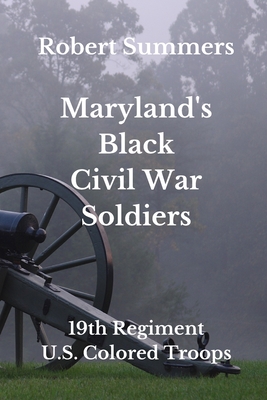Maryland's Black Civil War Soldiers: 19th Regiment, U.S. Colored Troops

Maryland's Black Civil War Soldiers: 19th Regiment, U.S. Colored Troops
Always in need of more men, the Union Army began enlisting African Americans about half way through the 1861-65 Civil War. Most were runaway slaves, but there were also a number of free black men, some who had been drafted, and some who had been paid to substitute for someone else, a controversial practice allowed during the war. The new African American units were designated the U. S.Colored Troops, consisting of 120 Infantry Regiments, 12 Heavy Artillery Regiments, 10 Heavy Artillery Batteries, and 7 Cavalry Regiments. This book profiles the 1,151 soldiers in one of the infantry regiments, Maryland's 19th Regiment. The information is taken from the soldiers' military service and pension records at the National Archives in Washington, D.C. Training of the 19th Regiment took place during the winter of 1863-64 at Camp Stanton near the port town of Benedict, Maryland on the Patuxent River, followed by two months in Baltimore in the Spring of 1864. In mid-April, the regiment marched to Washington, crossed the Potomac River into Virginia, and joined up with General Grant's Army of the Potomac. As Grant's army fought its way south towards Richmond and Petersburg during May and June 1864, the 19th Regiment saw action at the battles of the Wilderness, Spottsylvania, Topolotomy Creek, North Anna, Cold Harbor, and Old Church. Arriving at Petersburg, the 19th Regiment joined other Union troops in the trenches outside that besieged city. During the siege of Petersburg, the regiment saw action at the battles of Weldon Railroad, Poplar Grove Church, Bermuda Hundred, Chapin's Farm, and Hatcher's Run. The regiment's largest battle was as part of the Union Army's July 30, 1864 assault against Confederate forces outside Petersburg, Virginia. Many of its men were killed, wounded, or taken prisoner. The assault was recorded in military records at the time as the Battle of Cemetery Hill or the Battle of the Mine, but in later years was popularized as the Battle of the Crater. The fall of Petersburg came eight months later. On April 1st, General Grant sent the 19th and other regiments from Petersburg to attack Richmond. Sensing defeat, General Lee pulled his Confederate troops from Petersburg and Richmond the next day, retreating westward towards Appomattox. Early in the morning of April 3rd, the 19th Regiment's soldiers were among the first to enter Richmond. Captain James H. Rickard, commanding Company G, wrote in his company report that day: Advanced on the enemy's work
154.61Lei
154.61Lei
Livrare in 2-4 saptamani
Descrierea produsului
Always in need of more men, the Union Army began enlisting African Americans about half way through the 1861-65 Civil War. Most were runaway slaves, but there were also a number of free black men, some who had been drafted, and some who had been paid to substitute for someone else, a controversial practice allowed during the war. The new African American units were designated the U. S.Colored Troops, consisting of 120 Infantry Regiments, 12 Heavy Artillery Regiments, 10 Heavy Artillery Batteries, and 7 Cavalry Regiments. This book profiles the 1,151 soldiers in one of the infantry regiments, Maryland's 19th Regiment. The information is taken from the soldiers' military service and pension records at the National Archives in Washington, D.C. Training of the 19th Regiment took place during the winter of 1863-64 at Camp Stanton near the port town of Benedict, Maryland on the Patuxent River, followed by two months in Baltimore in the Spring of 1864. In mid-April, the regiment marched to Washington, crossed the Potomac River into Virginia, and joined up with General Grant's Army of the Potomac. As Grant's army fought its way south towards Richmond and Petersburg during May and June 1864, the 19th Regiment saw action at the battles of the Wilderness, Spottsylvania, Topolotomy Creek, North Anna, Cold Harbor, and Old Church. Arriving at Petersburg, the 19th Regiment joined other Union troops in the trenches outside that besieged city. During the siege of Petersburg, the regiment saw action at the battles of Weldon Railroad, Poplar Grove Church, Bermuda Hundred, Chapin's Farm, and Hatcher's Run. The regiment's largest battle was as part of the Union Army's July 30, 1864 assault against Confederate forces outside Petersburg, Virginia. Many of its men were killed, wounded, or taken prisoner. The assault was recorded in military records at the time as the Battle of Cemetery Hill or the Battle of the Mine, but in later years was popularized as the Battle of the Crater. The fall of Petersburg came eight months later. On April 1st, General Grant sent the 19th and other regiments from Petersburg to attack Richmond. Sensing defeat, General Lee pulled his Confederate troops from Petersburg and Richmond the next day, retreating westward towards Appomattox. Early in the morning of April 3rd, the 19th Regiment's soldiers were among the first to enter Richmond. Captain James H. Rickard, commanding Company G, wrote in his company report that day: Advanced on the enemy's work
Detaliile produsului










